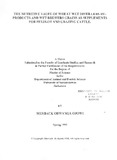| dc.description.abstract | Wet distillers by-products from wheat based ethanol production and wet brewers
grains (WBG) were evaluated as supplements in feedlot and grazing cattle diets. A
feedlot experiment used canola meal, WBG and wet distillers grains (WDG) as protein
supplements during the growing period. Three diets (control, WBG and WDG) were
used in a completely randomized design experiment. Average daily gain (ADG), dry
matter intake (DMI), feed conversion ratio (FCR), ultrasonic back fat thickness
(USF AT) and ultrasonic rib eye area (USREA) were measured throughout the trial.
Carcass fat thickness and composition were measured after slaughter. During the
growing period ADG and DMI were similar across all the treatments, however, steers
fed WBG diet tended (P<O.l 0) to have better feed conversions than control fed steers.
During the finishing phase the control fed steers grew faster (P<0.05) than the WBG fed
steers. Wet distillers grains fed cattle were intermediate. Fat and muscle deposition and
carcass characteristics were similar across treatments. However, carcass composition
indicated that WDG steers had more (P<O.Ol) intermuscular fat than control and WBG
and WBG had more subcutaneous fat (P<0.02) compared to the WDG group. These
results indicate that WDG and WBG may be used to replace standard feed ingredients in
the- grower ration.
An in situ nylon bag experiment was used to determine the dry matter (DM) and
crude protein (CP) degradation from WBG and WDG collected during (WBGT; WDGT)
and after (WBGP; WDGP) the trial. A completely randomized design experiment was
used with one fistulated cow and four feed samples. Three separate days were used to
carry out seven rumen incubations of 2, 4, 6, 8, 12, 24 and 48 h. Dry matter and CP
degradation was higher in WDG compared to WBG. Similarly, effective degradability
parameters indicated that WDG is more degradable than WBG. The high degradability
observed for WDG may be related to the higher soluble fraction and rate of degradation.
The results show that WBG has a higher rumen undegradable protein than WDG.
The value of thin stillage as an energy and protein supplement was determined for
growing cattle grazing crested wheatgrass. Forty steers were used in a trial in which
ADG, fluid intake, USFAT, DMI from stillage consumption and plasma metabolite
concentration were measured. Crested wheatgrass (CWG) pastures and thin stillage
samples collected during ihe trial were subjected to proximate analysis. Results of the
trial indicate that ADG, fluid intake, and DMI from stillage consumption were all higher
(P<O.05) for stillage fed cattle relative to the water group. Fat deposition and plasma
urea N, magnesium and phosphorus concentrations were also higher for stillage fed
cattle. The proximate analysis of thin stillage indicated high protein and energy content.
Similar analysis for CWG indicated a declining nutritional quality as the pastures
matured and the dry season progressed. The higher performance for the stillage fed cattle
in an indication of the higher nutritional status of the stillage fed cattle. In conclusion,
the results from these trials indicate that by-products from wheat based ethanol
production are valuable sources of nutrients for cattle managed under a variety of
production situations. | en |

